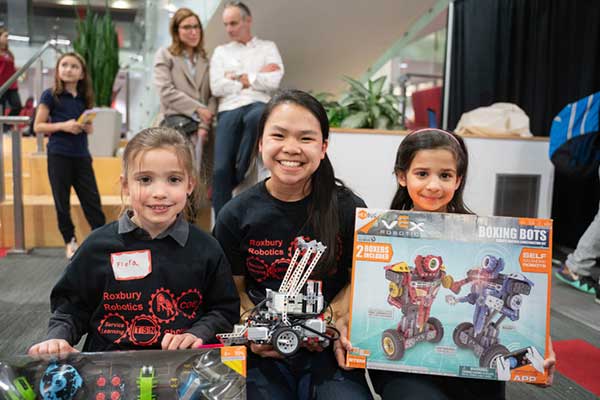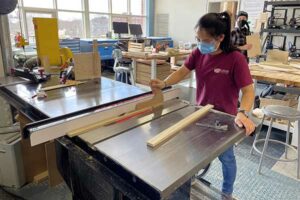Using Co-op as a Stepping Stone Towards a Full-Time Career

Magdalene Sexton Dwyer, E’23, civil engineering and architectural studies, found that her civil engineering ambitions were influenced by her architectural work on co-op and her service-based extracurriculars. By combining her academics with her personal goals, she decided to focus on affordable and sustainable housing.
Even before her first co-op, Magdalene Sexton Dwyer, E’23, civil engineering and architectural studies, was already getting real experience in the workforce through a summer internship at PPC Broadband, Inc. as a mechanical design engineer. In the summer after her first year at Northeastern, she sought out this internship opportunity on her own. Although her work at PPC was not directly related to what she was studying at the time, the internship was a source of valuable preparation for her time on co-op.
“I learned a lot about setting myself up for tasks, looking ahead to the week to make sure that I had things to work on and forming relationships with my supervisor and co-workers,” SextonDwyer says. “By the time that I did my first co-op through Northeastern, I knew what to expect in that regard.”
SextonDwyer’s first co-op at CHA Consulting, Inc. gave her the opportunity to apply both her workplace experience from her internship and her civil engineering knowledge from her courses. Although she did not work directly in the civil engineering department, she was able to build software skills that would help her later on. Using this software, she created electrical distribution designs for CHA clients to provide to contractors.
“I did get a really solid understanding of some of the software that is useful for both civil engineering and architecture,” she says. “It’s some of the software that I had learned briefly in Cornerstone of Engineering; AutoCAD was one of the main ones I used there.”
SextonDwyer says that as a first co-op, CHA gave her a good sense of the civil engineering industry and what kind of work she could expect to be a part of. Up until this point, her only major was civil engineering, but she wanted to focus more on creative design work. Once Northeastern created the civil engineering and architectural studies combined major, she realized that this was the best path for her.
“When I came to Northeastern, I was just studying civil engineering because they didn’t have the combined major yet,” SextonDwyer says. “By the time I finished that co-op, they had started that combined major, and I switched into that combined major so that I could get a bit more design experience.”
Her second co-op at Longfellow Design Build as a structural engineer and architectural designer reflected this change in direction. Longfellow is a custom housing design build company, so it paired nicely with SextonDwyer’s desire to focus on custom residential design. The smaller size of the team at Longfellow also gave her the chance to take on projects independently.
Although SextonDwyer enjoyed her work at Longfellow, it pushed her to consider her role and responsibility to make a meaningful contribution as an aspiring engineer and architect. When thinking about how she could bridge the gap between her academics and her service-based extracurriculars, SextonDwyer realized that she was more interested in affordable and sustainable housing.
“The experience I had working on Cape Cod designing fully custom homes helped me realize the importance of some of my priorities I hadn’t previously articulated,” SextonDwyer says. “I emerged from that co-op with a clear drive to explore affordable and sustainable housing over custom design.”
Even though she now had a new career goal in mind, SextonDwyer was grateful for the opportunities offered by Longfellow. She says that expanding her work beyond theoretical situations and interacting with real clients was an enriching experience that couldn’t be replicated in the classroom.
“When I was working at Longfellow and doing structural engineering for them, I was designing structural systems for the snow load in Massachusetts, which is much more tangible than just getting numbers from a textbook,” SextonDwyer says. “Having a real-world reason to use the formulas I learned in class, and real-world consequences to get calculations right, motivated me to truly understand the work I was doing.”

SextonDwyer working on a project for an architecture class at the CAMD makerspace.
Even though not all of her co-op work reflected the career she wants to pursue, her internship and these co-ops were just as crucial because they enabled her to navigate the workforce and gain authentic experience. Rather than spend years in the workforce after graduation trying to figure out her true ambitions, she was able to get a head start.
“Considering that most people work for 40 years of their lives, it’s helpful to have had experiences that will set me up for navigating professional settings for the rest of my life,” SextonDwyer says. “Being able to get a glimpse into the workforce and what a job actually entails is beyond valuable.”
While she was applying for her second co-op, SextonDwyer discovered Volumetric Building Companies, or VBC. Though she applied and was offered a position, she ultimately chose Longfellow. As she prepared for graduation, she reached back out to VBC in search of a full-time position. Not only was she offered a job, but the process was also much quicker due to her previous experience with the company.
“The process for getting hired here was a lot simpler than I think a typical job application process would be, which was really incredible and definitely a direct benefit of the co-op program,” SextonDwyer says.
SextonDwyer spent the first four months at VBC as a project designer intern, but she is now a full-time employee as an architectural designer. VBC is her first work experience in an environment with a primary focus on architecture. She’s still figuring out what role she wants to play, but she says she feels confident and motivated by the company’s mission.
During her time at Northeastern, SextonDwyer primarily involved herself in service-based clubs such as the Alliance of Civically Engaged Students, or ACES. The club helps students get involved in non-profit and volunteering communities in Boston through community service partnerships.
“That really helped me learn about Boston and sparked a whole separate area of what I was interested in,” SextonDwyer says. “I think sometimes students will equate what they’re passionate about with their work, and I found that through community service and because of ACES, I could have something completely separate from what I wanted to do for work as a personal passion.”
SextonDwyer also involved herself with the service-learning program at Northeastern as a teaching assistant and a team manager and through Roxbury Robotics. She also went on several alternative spring break trips, both as a participant and as a leader. She says that throughout her entire Northeastern journey, these were the most impactful experiences for her.

SextonDwyer playing soccer with her team while on an alternative spring break at the Tandana Foundation.
“The places I went and the people I collaborated with through service made me think critically about how I move through the world,” she says. “My experiences through service-learning, Roxbury Robotics, alternative spring breaks and ACES were the most serving in teaching me how to connect with and unite a diverse group of people, seek and develop my passions and advocate for the things I believe in.”
Now that she has graduated, SextonDwyer wants to continue to use her work to address challenges such as climate change and the housing crisis. Her education and her shift towards architecture have helped empower her efforts. She says that she’s still learning of new technologies and industries that are leading the way towards solutions to these challenges, but working at VBC has been a step in the right direction for her.
“One of the reasons I was so drawn to Volumetric Building Companies is because they are designing modular housing and producing their housing through modular manufacturing,” SextonDwyer says. “So their whole process of designing construction is far more sustainable, faster and safer.”
Staying involved with companies that have a true commitment to sustainability and social justice is what SextonDwyer wants to devote her time to from now on. The most important value she has learned from her co-op experiences is that daring to ask questions is the first step to making true career progress.
“I think one of the greatest things about co-op is that you’re surrounded by people who potentially have similar interests and career paths that you are hoping to follow,” SextonDwyer says. “Everyone around you is a wealth of knowledge who may lead you to your next passion. Even if you don’t follow their footsteps, there is something to learn from every person and experience.”